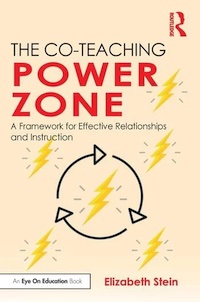How to Create a Co-Teaching Power Zone
By Elizabeth Stein
 What is the first word that comes to mind when thinking about co-teaching? This decades-old question continues to reveal mixed emotions and experiences depending on who you ask. Yet there is one very common, ongoing response to this question. Are you ready? Drumroll, please (I can’t resist a good drumroll moment)…
What is the first word that comes to mind when thinking about co-teaching? This decades-old question continues to reveal mixed emotions and experiences depending on who you ask. Yet there is one very common, ongoing response to this question. Are you ready? Drumroll, please (I can’t resist a good drumroll moment)…
The word is…Power.
No surprise, right? Now…please return to your first word, image, or feeling that came to mind. I bet your thought either directly or indirectly connected with the notion of power dynamics in the classroom. It’s no secret that negotiating power within a co-teaching partnership is tricky business.
Research shows that, typically. the general educator takes the lead while the special educator falls into what feels like the teaching abyss – standing off to the side or in the back of the room. In my travels, I’ve also seen many cases where the special educator takes a strong lead, leaving the general educator frustrated. This power imbalance seems to be far too familiar for far too many.
So how about we explore a natural process of power sharing? How do we achieve effective co-teaching power dynamics where both teachers are valued and empowered?
The answer is we engage in a process anchored in self-awareness, supported by shared knowledge of meaningful co-teaching practices, and actualized through a new way of thinking about collaboration.
With the new school year beginning for some and peeking around the corner for others, let’s consider ways to FINALLY empower our co-teaching selves.
Welcome to the Co-Teaching Power Zone (CPZ)!
The CPZ framework allows for a dynamic exchange of co-teaching power as each co-teacher has their basic needs supported and nurtured within a much-needed partnership approach.
According to Ryan and Deci (2017), three basic needs support an individual’s growth and overall well-being. The CPZ framework structures a co-teaching relationship by guiding each co-teacher to raise their self-awareness by honoring and nurturing the three basic needs.
►Autonomy: Each co-teacher considers their willingness to co-teach and then endorses their actions. When co-teachers feel autonomous, they connect their reason for co-teaching with their actions in a way that supports a partnership approach. If a teacher feels forced into a co-teaching experience, their actions may be guarded with a genuine lack of autonomy.
►Competence: Each co-teacher feels capable as an active participant in all phases of the co-teaching process. Their actions are based on the belief that they have the skills needed to co-teach in meaningful ways. Feeling competent in the co-teaching power zone includes the natural process of continuing to strengthen one’s teaching and learning process.
►Relatedness: Each co-teacher needs to experience a sense of belonging to optimally work together. Within the co-teaching power zone, co-teachers feel that their contributions to the process of teaching and learning are valued and make a difference for the classroom community as a whole.
Now that we’re grounded in self-awareness about the basic needs in any teacher to teacher working relationship, the CPZ allows co-teachers to flow into an expanded view of meaningful collaboration.
Connecting, Disconnecting, and Re-Connecting
Typically when we think about collaboration, conversations are all about how two teachers must work together. THAT is collaborating after all. Keeping that truth in mind, let’s get to one strong additional, unique aspect of making co-teaching work when you are in the co-teaching power zone.
It is about illuminating the organic need for co-teachers to disconnect within the process of working together. What?! Yes, you read correctly. Disconnection is a natural part of any growth-fostering relationship (Miller, 1976). It’s during this step in the collaborative process that each co-teacher considers ways to apply their unique skill set.
The process looks something like this:
►Connecting: Co-teachers share ideas, brainstorm, reflect, and plan. Opportunities to grow mutual respect and authentic connection occur here.
►Disconnecting: Individually, co-teachers plan, research, and consider ways to apply their skills to an upcoming learning experience. This could even be a time for each to just take a breath to embrace their wellness within the teaching and learning process. Opportunities for personal and professional growth are experienced here.
►Re-Connecting: Each co-teacher shares and melds their ideas with the other. They trust the co-teaching process as each co-teacher contributes their unique expertise and skill set. This is a time to embrace each another’s perspectives and bring that magic into the classroom with the students. Personal, professional, and collective growth happens here.
Getting Started
The good news is any co-teaching pair has already entered the power zone – by the mere fact that they are placed together. Yet how are they using their power? The co-teaching power zone is designed to embrace every pairing along a natural unique progression toward a growth-fostering relationship. To get started in optimizing your truest sense of co-teaching and collaboration consider two new ways of experiencing co-teaching.
1. Gain a stronger awareness of what motivates you to co-teach and invite your co-teacher to do the same – and then share! Get the lines of communication sparking by meeting each other where you are – and valuing one another with a new awareness and willingness to experience your partnership.
2. Expand your views of what it means to achieve the most meaningful collaboration process during co-teaching. It is not just about being in action with one another, Also notice the opportunities for you to disconnect along an organic process of connecting and reconnecting. This disconnection allows each co-teacher to ground themselves in fulfilling their three basic needs – where they experience autonomy, competence, and relatedness. Through the essential process of reconnecting, co-teachers honor each other’s expertise as they come together in partnership.
Co-teachers, we can choose to experience co-teaching within a “power over” imbalanced experience, or we can embody our best vision of co-teaching through a dynamic exchange of individual and collective power – truly in partnership with one another.
For more conversations about this, connect with me anytime by leaving a comment right here in the comment section, commenting at my website, www.steinelizabeth.com, or using the hashtag #CoTeachat on X-Twitter to share your connections and questions.

Elizabeth is the author of The Co-Teaching Power Zone (Routledge/Eye On Education, 2024) upon which this article is based. She is also the author of Humanizing Classroom Management: Restorative Practices and Universal Design for Learning (CAST, 2024).
Other works by Elizabeth include Elevating Co-teaching with Universal Design for Learning, Revised and Expanded Edition (CAST, 2023), Two Teachers in the Room: Strategies for Co-teaching Success (Routledge/Eye On Education, 2017) and other articles and publications, including her long-running MiddleWeb column. You can follow Elizabeth on X-Twitter @ElizabethLStein and visit her website at https://www.steinelizabeth.com/.
Feature image by Ricarda Mölck from Pixabay






























